剑桥雅思8的阅读长难句汇总(2)
【最新】雅思阅读长难句100句及翻译(2)-范文word版 (1页)
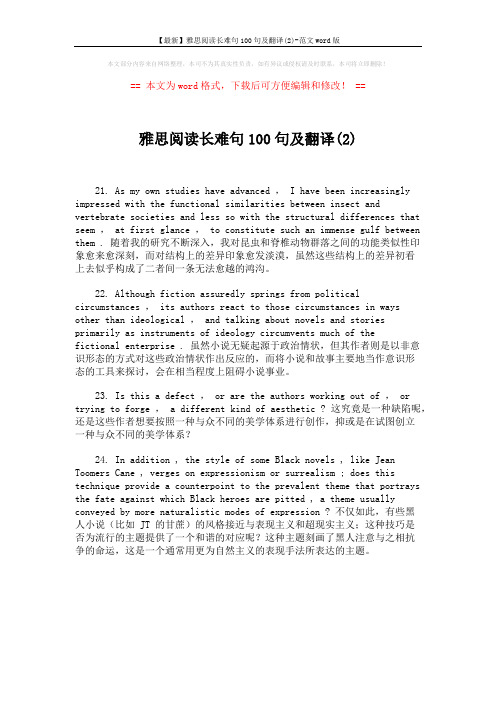
【最新】雅思阅读长难句100句及翻译(2)-范文word版本文部分内容来自网络整理,本司不为其真实性负责,如有异议或侵权请及时联系,本司将立即删除!== 本文为word格式,下载后可方便编辑和修改! ==雅思阅读长难句100句及翻译(2)21. As my own studies have advanced , I have been increasingly impressed with the functional similarities between insect and vertebrate societies and less so with the structural differences that seem , at first glance , to constitute such an immense gulf between them . 随着我的研究不断深入,我对昆虫和脊椎动物群落之间的功能类似性印象愈来愈深刻,而对结构上的差异印象愈发淡漠,虽然这些结构上的差异初看上去似乎构成了二者间一条无法愈越的鸿沟。
22. Although fiction assuredly springs from political circumstances , its authors react to those circumstances in ways other than ideological , and talking about novels and stories primarily as instruments of ideology circumvents much of thefictional enterprise . 虽然小说无疑起源于政治情状,但其作者则是以非意识形态的方式对这些政治情状作出反应的,而将小说和故事主要地当作意识形态的工具来探讨,会在相当程度上阻碍小说事业。
雅思长难句2
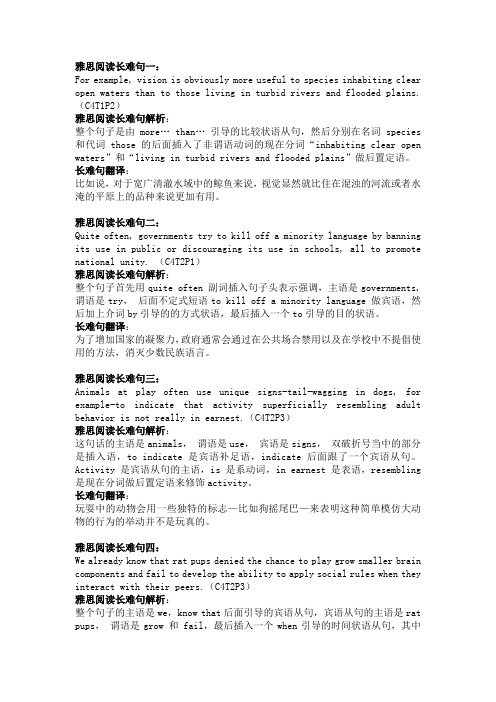
雅思阅读长难句一:For example, vision is obviously more useful to species inhabiting clear open waters than to those living in turbid rivers and flooded plains.(C4T1P2)雅思阅读长难句解析:整个句子是由more… than… 引导的比较状语从句,然后分别在名词species 和代词those的后面插入了非谓语动词的现在分词“inhabiting clear open waters”和“living in turbid rivers and flooded plains”做后置定语。
长难句翻译:比如说,对于宽广清澈水域中的鲸鱼来说,视觉显然就比住在混浊的河流或者水淹的平原上的品种来说更加有用。
雅思阅读长难句二:Quite often, governments try to kill off a minority language by banning its use in public or discouraging its use in schools, all to promote national unity. (C4T2P1)雅思阅读长难句解析:整个句子首先用quite often 副词插入句子头表示强调,主语是governments, 谓语是try,后面不定式短语to kill off a minority language 做宾语,然后加上介词by引导的的方式状语,最后插入一个to引导的目的状语。
长难句翻译:为了增加国家的凝聚力,政府通常会通过在公共场合禁用以及在学校中不提倡使用的方法,消灭少数民族语言。
雅思阅读长难句三:Animals at play often use unique signs-tail-wagging in dogs, for example-to indicate that activity superficially resembling adult behavior is not really in earnest.(C4T2P3)雅思阅读长难句解析:这句话的主语是animals,谓语是use,宾语是signs,双破折号当中的部分是插入语,to indicate是宾语补足语,indicate后面跟了一个宾语从句。
(完整word版)剑桥雅思8阅读理解解析含翻译

剑桥雅思8-第三套试题-阅读部分-PASSAGE 1-阅读真题原文部分:READING PASSAGE 1You should spend about 20 minutes on Questions 1-13 which are based on Reading Passage 1 below.Striking Back at Lightning With LasersSeldom is the weather more dramatic than when thunderstorms strike. Their electrical fury inflicts death or serious injury on around 500 people each year in the United States alone. As the clouds roll in, a leisurely round of golf can become a terrifying dice with death - out in the open, a lone golfer may be a lightning bolt's most inviting target. And there is damage to property too. Lightning damage costs American power companies more than $100 million a year.But researchers in the United States and Japan are planning to hit back. Already in laboratory trials they have tested strategies for neutralising the power of thunderstorms, and this winter they will brave real storms, equipped with an armoury of lasers that they will be pointing towards the heavens to discharge thunderclouds before lightning can strike.The idea of forcing storm clouds to discharge their lightning on command is not new. In the early 1960s, researchers tried firing rockets trailing wires into thunderclouds to set up an easy discharge path for the huge electric charges that these clouds generate. The technique survives to this day at a test site in Florida run by the University of Florida, with support from the Electrical Power Research Institute (EPRI), based in California. EPRI, which is funded by power companies, is looking at ways to protect the United States' power grid from lightning strikes. 'We can cause the lightning to strike where we want it to using rockets, ' says Ralph Bernstein, manager of lightning projects at EPRI. The rocket site is providing precise measurements of lightning voltages and allowing engineers to check how electrical equipment bears up.Bad behaviourBut while rockets are fine for research, they cannot provide the protection from lightning strikes that everyone is looking for. The rockets cost around $1, 200 each, can only be fired at a limited frequency and their failure rate is about 40 per cent. And even when they do trigger lightning, things still do not always go according to plan. 'Lightning is not perfectly well behaved, 'says Bernstein. 'Occasionally, it will take a branch and go someplace it wasn't supposed to go. ' And anyway, who would want to fire streams of rockets in a populated area? 'What goes up must come down, ' points out Jean-Claude Diels of the University of New Mexico. Diels is leading a project, which is backed by EPRI, to try to use lasers to discharge lightning safely - and safety is a basic requirement since no one wants to put themselves or their expensive equipment at risk. With around $500, 000 invested so far, a promising system is just emerging from the laboratory.The idea began some 20 years ago, when high-powered lasers were revealing their ability to extract electrons out of atoms and create ions. If a laser could generate a line of ionisation in the air all the way up to a storm cloud, this conducting path could be used to guide lightning to Earth, before the electric field becomes strong enough to break down the air in an uncontrollable surge. To stop the laser itself being struck, it would not be pointed straight at the clouds. Instead it would be directed at a mirror, and from there into the sky. The mirror would be protected by placing lightning conductors close by. Ideally, the cloud-zapper (gun)would be cheap enough to be installed around all key power installations, and portable enough to be taken to international sporting events to beam up at brewing storm clouds.A stumbling blockHowever, there is still a big stumbling block. The laser is no nifty portable: it's a monster that takes up a whole room. Diels is trying to cut down the size and says that a laser around the size of a small table is in the offing. He plans to test this more manageable system on live thunderclouds next summer.Bernstein says that Diels's system is attracting lots of interest from the power companies. But they have not yet come up with the $5 million that EPRI says will be needed to develop a commercial system, by making the lasers yet smaller and cheaper. 'I cannot say I have money yet, but I'm working on it, ' says Bernstein. He reckons that the forthcoming field tests will be the turning point - and he's hoping for good news. Bernstein predicts 'an avalanche of interest and support' if all goes well. He expects to see cloud-zappers eventually costing 100, 000 each.Other scientists could also benefit. With a lightning 'switch' at their fingertips, materials scientists could find out what happens when mighty currents meet matter. Diels also hopes to see the birth of 'interactive meteorology' - not just forecasting the weather but controlling it. 'If we could discharge clouds, we might affect the weather, ' he says.And perhaps, says Diels, we'll be able to confront some other meteorological menaces. 'We think we could prevent hail by inducing lightning, ' he says. Thunder, the shock wave that comes from a lightning flash, is thought to be the trigger for the torrential rain that is typical of storms. A laser thunder factory could shake the moisture out of clouds, perhaps preventing the formation of the giant hailstones that threaten crops. With luck, as the storm clouds gather this winter, laser-toting researchers could, for the first time, strike back.Questions 1-3Choose the correct letter, A, B, C or D.Write the correct letter in boxes 1-3 on your answer sheet.1 The main topic discussed in the text isA the damage caused to US golf courses and golf players by lightning strikes.B the effect of lightning on power supplies in the US and in Japan.C a variety of methods used in trying to control lightning strikes.D a laser technique used in trying to control lightning strikes.2 According to the text, every year lightningA does considerable damage to buildings during thunderstorms.B kills or injures mainly golfers in the United States.C kills or injures around 500 people throughout the world.D damages more than 100 American power companies.3 Researchers at the University of Florida and at the University of New MexicoA receive funds from the same source.B are using the same techniques.C are employed by commercial companies.D are in opposition to each other.Questions 4-6Complete the sentences below.Choose NO MORE THAN TWO WORDS from the passage for each answer.Write your answers in boxes 4-6 on your answer sheet.4 EPRI receives financial support from………………………….5 The advantage of the technique being developed by Diels is that it can be used……………….6 The main difficulty associated with using the laser equipment is related to its……………….Questions 7-10Complete the summary using the list of words, A-I, below.Write the correct letter, A-I, in boxes 7-10 on your answer sheet.In this method, a laser is used to create a line of ionisation by removing electrons from 7 …………………………. This laser is then directed at 8 …………………………in order to control electrical charges, a method which is less dangerous than using 9 …………………………. As a protection for the lasers, the beams are aimed firstly at 10………………………….A cloud-zappersB atomsC storm cloudsD mirrorsE techniqueF ionsG rockets H conductors I thunderQuestions 11-13Do the following statements agree with the information given in Reading Passage 1?In boxes 11-13 on your answer sheet writeYES if the statement agrees with the claims of the writerNO if the statement contradicts the claims of the writerNOT GIVEN if it is impossible to say what the writer thinks about this11 Power companies have given Diels enough money to develop his laser.12 Obtaining money to improve the lasers will depend on tests in real storms.13 Weather forecasters are intensely interested in Diels's system.READING PASSAGE 1篇章结构体裁说明文主题用激光回击闪电结构第1段:闪电带来的危害第2段:科研人员正在研究回击闪电的方法第3段:先前的闪电回击术介绍第4段:火箭回击术的缺陷第5段:更安全的激光回击术第6段:激光回击术的技术原理第7段:激光回击术的缺陷第8段:通过实地实验改进激光回击术第9段:激光回击术对其他学科也有益处第10段:激光回击术的其他用途解题地图难度系数:★★★解题顺序:按题目顺序解答即可友情提示:烤鸭们注意:本文中的SUMMARY题目顺序有改变,解题要小心;MULTIPLE CHOICE的第三题是个亮点,爱浮想联翩的烤鸭们可能会糊掉。
剑桥雅思阅读解析8(test2)
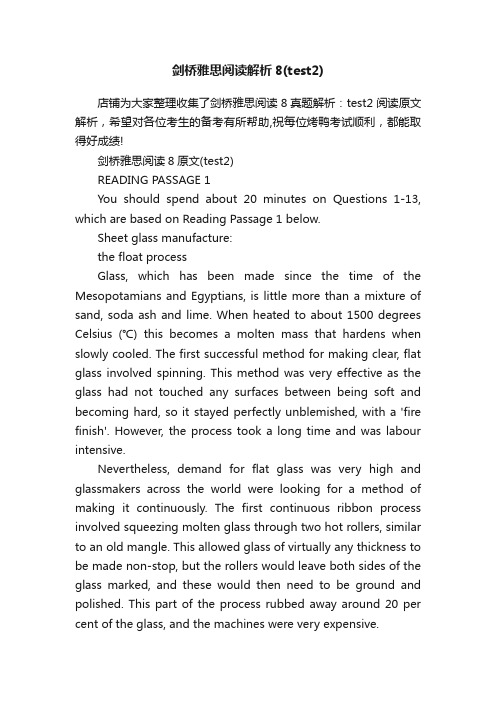
剑桥雅思阅读解析8(test2)店铺为大家整理收集了剑桥雅思阅读8真题解析:test2阅读原文解析,希望对各位考生的备考有所帮助,祝每位烤鸭考试顺利,都能取得好成绩!剑桥雅思阅读8原文(test2)READING PASSAGE 1You should spend about 20 minutes on Questions 1-13, which are based on Reading Passage 1 below.Sheet glass manufacture:the float processGlass, which has been made since the time of the Mesopotamians and Egyptians, is little more than a mixture of sand, soda ash and lime. When heated to about 1500 degrees Celsius (℃) this becomes a molten mass that hardens when slowly cooled. The first successful method for making clear, flat glass involved spinning. This method was very effective as the glass had not touched any surfaces between being soft and becoming hard, so it stayed perfectly unblemished, with a 'fire finish'. However, the process took a long time and was labour intensive.Nevertheless, demand for flat glass was very high and glassmakers across the world were looking for a method of making it continuously. The first continuous ribbon process involved squeezing molten glass through two hot rollers, similar to an old mangle. This allowed glass of virtually any thickness to be made non-stop, but the rollers would leave both sides of the glass marked, and these would then need to be ground and polished. This part of the process rubbed away around 20 per cent of the glass, and the machines were very expensive.The float process for making flat glass was invented by Alistair Pilkington. This process allows the manufacture of clear, tinted and coated glass for buildings, and clear and tinted glass for vehicles. Pilkington had been experimenting with improving the melting process, and in 1952 he had the idea of using a bed of molten metal to form the flat glass, eliminating altogether the need for rollers within the float bath. The metal had to melt at a temperature less than the hardening point of glass (about 600℃), but could not boil at a temperature below the temperature of the molten glass (about 1500℃). The best meta l for the job was tin.The rest of the concept relied on gravity, which guaranteed that the surface of the molten metal was perfectly flat and horizontal. Consequently, when pouring molten glass onto the molten tin, the underside of the glass would also be perfectly flat. If the glass were kept hot enough, it would flow over the molten tin until the top surface was also flat, horizontal and perfectly parallel to the bottom surface. Once the glass cooled to 604℃ or less it was too hard to mark and could be transported out of the cooling zone by rollers. The glass settled to a thickness of six millimetres because of surface tension interactions between the glass and the tin. By fortunate coincidence, 60 per cent of the flat glass market at that time was for six-millimetre glass.Pilkington built a pilot plant in 1953 and by 1955 he had convinced his company to build a full-scale plant. However, it took 14 months of non-stop production, costing the company £100,000 a month, before the plant produced any usable glass. Furthermore, once they succeeded in making marketable flat glass, the machine was turned off for a service to prepare it for years of continuous production. When it started up again it took another four months to get the process right again. They finallysucceeded in 1959 and there are now float plants all over the world, with each able to produce around 1000 tons of glass every day, non-stop for around 15 years.Float plants today make glass of near optical quality. Several processes —melting, refining, homogenising —take place simultaneously in the 2000 tonnes of molten glass in the furnace. They occur in separate zones in a complex glass flow driven by high temperatures. It adds up to a continuous melting process, lasting as long as 50 hours, that delivers glass smoothly and continuously to the float bath, and from there to a coating zone and finally a heat treatment zone, where stresses formed during cooling are relieved.The principle of float glass is unchanged since the 1950s. However, the product has changed dramatically, from a single thickness of 6.8 mm to a range from sub-millimetre to 25 mm, from a ribbon frequently marred by inclusions and bubbles to almost optical perfection. To ensure the highest quality, inspection takes place at every stage. Occasionally, a bubble is not removed during refining, a sand grain refuses to melt, a tremor in the tin puts ripples into the glass ribbon. Automated on-line inspection does two things. Firstly, it reveals process faults upstream that can be corrected. Inspection technology allows more than 100 million measurements a second to be made across the ribbon, locating flaws the unaided eye would be unable to see. Secondly, it enables computers downstream to steer cutters around flaws.Float glass is sold by the square metre, and at the final stage computers translate customer requirements into patterns of cuts designed to minimise waste.Questions 1-8Complete the table and diagram below.Choose NO MORE THAN TWO WORDS from the passage for each answer.Write your answers in boxes 1-8 on your answer sheet.Early methods of producing flat glassMethod Advantages Disadvantages1............Glass remained2........... ? Slow3.............RibbonCould produce glass sheets of varying 4.............non-stop process ? Glass was 5...........20% of glass rubbed awayMachines were expensive图片11Questions 9-13Do the following statements agree with the information given in Reading Passage 1?In boxes 9-13 on your answer sheet, writeTRUE if the statement agrees with the informationFALSE if the statement contradicts the informationNOT GIVEN if there is no information on this9 The metal used in the float process had to have specific properties.10 Pilkington invested some of his own money in his float plant.11 Pilkington’s first full-scale plant was an instant commercial success.12 The process invented by Pilkington has now beenimproved.13 Computers are better than humans at detecting faults in glass.READING PASSAGE 2You should spend about 20 minutes on Questions 14-26, which are based on Reading Passage 2 on the following pages.Question 14-17Reading passage 2 has six paragraphs, A-F.Choose the correct heading for paragraphs B and D-F from the list of headings below.Write the correct number, i-ix, in boxes 14-17 on your answer sheet.List of Headingsi Predicting climatic changesii The relevance of the Little Ice Age todayiii How cities contribute to climate change.iv Human impact on the climatev How past climatic conditions can be determinedvi A growing need for weather recordsvii A study covering a thousand yearsviii People have always responded to climate changeix Enough food at lastExample AnswerParagraph A Viii14 Paragraph BExample AnswerParagraph C V15 Paragraph D16 Paragraph E17 Paragraph FTHE LITTLE ICE AGEA This book will provide a detailed examination of the Little Ice Age and other climatic shifts, but, before I embark on that, let me provide a historical context. We tend to think of climate — as opposed to weather — as something unchanging, yet humanity has been at the mercy of climate change for its entire existence, with at least eight glacial episodes in the past 730,000 years. Our ancestors adapted to the universal but irregular global warming since the end of the last great Ice Age, around 10,000 years ago, with dazzling opportunism. They developed strategies for surviving harsh drought cycles, decades of heavy rainfall or unaccustomed cold; adopted agriculture and stock-raising, which revolutionised human life; and founded the world's first pre-industrial civilisations in Egypt, Mesopotamia and the Americas. But the price of sudden climate change, in famine, disease and suffering, was often high.B The Little Ice Age lasted from roughly 1300 until the middle of the nineteenth century. Only two centuries ago, Europe experienced a cycle of bitterly cold winters; mountain glaciers in the Swiss Alps were the lowest in recorded memory, and pack ice surrounded Iceland for much of the year. The climatic events of the Little Ice Age did more than help shape the modern world. They are the deeply important context for the current unprecedented global warming. The Little Ice Age was far from a deep freeze, however; rather an irregular seesaw of rapid climatic shifts, few lasting more than a quarter-century, driven by complex and still little understood interactions between the atmosphere and the ocean. The seesaw brought cycles of intensely cold winters and easterly winds, then switched abruptly to years of heavy spring and early summer rains, mild winters,and frequent Atlantic storms, or to periods of droughts, light northeasterly winds, and summer heat waves.C Reconstructing the climate changes of the past is extremely difficult, because systematic weather observations began only a few centuries ago, in Europe and North America. Records from India and tropical Africa are even more recent. For the time before records began, we have only 'proxy records' reconstructed largely from tree rings and ice cores, supplemented by a few incomplete written accounts. We now have hundreds of tree-ring records from throughout the northern hemisphere, and many from south of the equator, too, amplified with a growing body of temperature data from ice cores drilled in Antarctica, Greenland, the Peruvian Andes, and other locations, we are close to a knowledge of annual summer and winter temperature variations over much of the northern hemisphere going back 600 years.D This book is a narrative history of climatic shifts during the past ten centuries, and some of the ways in which people in Europe adapted to them. Part One describes the Medieval Warm Period, roughly 900 to 1200. During these three centuries, Norse voyagers from Northern Europe explored northern seas, settled Greenland, and visited North America. It was not a time of uniform warmth, for then, as always since the Great Ice Age, there were constant shifts in rainfall and temperature. Mean European temperatures were about the same as today, perhaps slightly cooler.E It is known that the Little Ice Age cooling began in Greenland and the Arctic in about 1200. As the Arctic ice pack spread southward, Norse voyages to the west were rerouted into the open Atlantic, then ended altogether. Storminess increased in the North Atlantic and North Sea. Colder, much wetter weatherdescended on Europe between 1315 and 1319, when thousands perished in a continent-wide famine. By 1400, the weather had become decidedly more unpredictable and stormier, with sudden shifts and lower temperatures that culminated in the cold decades of the late sixteenth century. Fish were a vital commodity in growing towns and cities, where food supplies were a constant concern. Dried cod and herring were already the staples of the European fish trade, but changes in water temperatures forced fishing fleets to work further offshore. The Basques, Dutch, and English developed the first offshore fishing boats adapted to a colder and stormier Atlantic. A gradual agricultural revolution in northern Europe stemmed from concerns over food supplies at a time of rising populations. The revolution involved intensive commercial farming and the growing of animal fodder on land not previously used for crops. The increased productivity from farmland made some countries self-sufficient in grain and livestock and offered effective protection against famine.F Global temperatures began to rise slowly after 1850, with the beginning of the Modern Warm Period. There was a vast migration from Europe by land-hungry farmers and others, to which the famine caused by the Irish potato blight contributed, to North America, Australia, New Zealand, and southern Africa. Millions of hectares of forest and woodland fell before the newcomers' axes between 1850 and 1890, as intensive European farming methods expanded across the world. The unprecedented land clearance released vast quantities of carbon dioxide into the atmosphere, triggering for the first time humanly caused global warming. Temperatures climbed more rapidly in the twentieth century as the use of fossil fuels proliferated and greenhouse gas levels continued to soar. The rise has been even steeper since theearly 1980s. The Little Ice Age has given way to a new climatic regime, marked by prolonged and steady warming. At the same time, extreme weather events like Category 5 hurricanes are becoming more frequent.Questions 18-22Complete the summary using the list of words, A-I, below.Write the correct letter, A-I, in boxes 18-22 on your answer sheet.Weather during the Little Ice AgeDocumentation of past weather conditions is limited: our main sources of knowledge of conditions in the distant past are 18...........and 19.................. We can deduce that the Little Ice Age was a time of 20.............. , rather than of consistent freezing. Within it there were some periods of very cold winters, other of 21...............and heavy rain, and yet others that saw 22................with no rain at all.A climatic shiftsB ice coresC tree ringsD glaciersE interactionsF weather observationsG heat waves H storms I written accountsQuestions 23-26Classify the following events as occurring during theA Medieval Warm PeriodB Little Ice AgeC Modern Warm PeriodWrite the correct letter, A, B or C, in boxes 23-26 on your answer sheet.23 Many Europeans started farming abroad.24 The cutting down of trees began to affect the climate.25 Europeans discovered other lands.26 Changes took place in fishing patterns.READING PASSAGE 3You should spend about 20 minutes on Questions 27-40, which are based on Reading Passage 3 on the following pages.Questions 27-32Reading Passage 3 has six paragraphs, A-F.Choose the correct heading for each paragraph from the list of headings below.Write the correct number, i-viii, in boxes 27-32 on your answer sheet.List of Headingsi The difficulties of talking about smellsii The role of smell in personal relationshipsiii Future studies into smelliv The relationship between the brain and the nosev The interpretation of smells as a factor in defining groups vi Why our sense of smell is not appreciatedvii Smell is our superior senseviii The relationship between smell and feelings27 paragraph A28 paragraph B29 paragraph C30 paragraph D31 paragraph E32 paragraph FThe meaning and power of smellThe sense of smell, or olfaction, is powerful. Odours affect us on a physical, psychological and social level. For the most part, however, we breathe in the aromas which surround us without being consciously aware of their importance to us. It is only when the faculty of smell is impaired for some reason that we begin torealise the essential role the sense of smell plays in our sense of well-beingA A survey conducted by Anthony Synott at Montreal's Concordia University asked participants to comment on how important smell was to them in their lives. It became apparent that smell can evoke strong emotional responses. A scent associated with a good experience can bring a rush of joy, while a foul odour or one associated with a bad memory may make us grimace with disgust. Respondents to the survey noted that many of their olfactory likes and dislikes were based on emotional associations. Such associations can be powerful enough so that odours that we would generally label unpleasant become agreeable, and those that we would generally consider fragrant become disagreeable for particular individuals. The perception of smell, therefore, consists not only of the sensation of the odours themselves, but of the experiences and emotions associated with them.B Odours are also essential cues in social bonding. One respondent to the survey believed that there is no true emotional bonding without touching and smelling a loved one. In fact, infants recognise the odours of their mothers soon after birth and adults can often identify their children or spouses by scent. In one well-known test, women and men were able to distinguish by smell alone clothing worn by their marriage partners from similar clothing worn by other people. Most of the subjects would probably never have given much thought to odour as a cue for identifying family members before being involved in the test, but as the experiment revealed, even when not consciously considered, smells register.C In spite of its importance to our emotional and sensorylives, smell is probably the most undervalued sense in many cultures. The reason often given for the low regard in which smell is held is that, in comparison with its importance among animals, the human sense of smell is feeble and undeveloped. While it is true that the olfactory powers of humans are nothing like as fine as those possessed by certain animals, they are still remarkably acute. Our noses are able to recognise thousands of smells, and to perceive odours which are present only in extremely small quantities.D Smell, however, is a highly elusive phenomenon. Odours, unlike colours, for instance, cannot be named in many languages because the specific vocabulary simply doesn't exist. ‘It smells like…,’ we have to say when describing an odour, struggling to express our olfactory experience. Nor can odours be recorded: there is no effective way to either capture or store them over time. In the realm of olfaction, we must make do with descriptions and recollections. This has implications for olfactory research.E Most of the research on smell undertaken to date has been of a physical scientific nature. Significant advances have been made in the understanding of the biological and chemical nature of olfaction, but many fundamental questions have yet to be answered. Researchers have still to decide whether smell is one sense or two — one responding to odours proper and the other registering odourless chemicals in the air. Other unanswered questions are whether the nose is the only part of the body affected by odours, and how smells can be measured objectively given the non-physical components. Questions like these mean that interest in the psychology of smell is inevitably set to play an increasingly important role for researchers.F However, smell is not simply a biological and psychologicalphenomenon. Smell is cultural, hence it is a social and historical phenomenon. Odours are invested with cultural values: smells that are considered to be offensive in some cultures may be perfectly acceptable in others. Therefore, our sense of smell is a means of, and model for, interacting with the world. Different smells can provide us with intimate and emotionally charged experiences and the value that we attach to these experiences is interiorised by the members of society in a deeply personal way. Importantly, our commonly held feelings about smells can help distinguish us from other cultures. The study of the cultural history of smell is, therefore, in a very real sense, an investigation into the essence of human culture.Questions 33-36Choose the correct letter, A, B, C or D.Write the correct letter in boxes 33-36 on your answer sheet.33 According to the introduction, we become aware of the importance of smell whenA we discover a new smell.B we experience a powerful smell.C our ability to smell is damaged.D we are surrounded by odours.34 The experiment described in paragraph BA shows how we make use of smell without realising it.B demonstrates that family members have a similar smell.C proves that a sense of smell is learnt.D compares the sense of smell in males and females.35 What is the write doing in paragraph C?A supporting other researchB making a proposalC rejecting a common beliefD describing limitations36 What does the write suggest about the study of smell in the atmosphere in paragraph E?A The measurement of smell is becoming more accurate.B Researchers believe smell is a purely physical reaction.C Most smells are inoffensive.D Smell is yet to be defined.Questions 37-40Complete the sentences below.Choose ONE WORD ONLY from the passage for each answer.Write your answers in boxes 37-40 on your answer sheet.37 Tests have shown that odours can help people recognise the.......... belonging to their husbands and wives.38 Certain linguistic groups may have difficulty describing smell because they lack the appropriate ................ .39 The sense of smell may involve response to................ which do not smell, in addition to obvious odours.40 Odours regarded as unpleasant in certain.................are not regarded as unpleasant in others.剑桥雅思阅读8原文参考译文(test2)PASSAGE 1 参考译文:玻璃板制造:浮法工艺早在美索不达米亚时期和古埃及时期人们就开始制造玻璃,当时制作出的玻璃只不过是沙子、碳酸钠和石灰的混合物而已。
剑桥雅思8真题及解析Test2阅读

目录剑桥雅思8阅读解析Test2Passage1 2剑桥雅思8阅读解析Test2Passage2 6剑桥雅思8阅读解析Test2Passage3 9剑桥雅思8阅读解析Test2Passage1体裁:说明文主要内容:平板玻璃的制造发展历史。
结构:第 1 段 :最早的平板玻璃制作方法 :抽丝法。
第 2 段 :持续制造平板玻璃的另一种方法 :带状法。
第 3 段 :浮法玻璃制造法。
第 4 段 :浮法玻璃制造过程。
第 5 段 :浮法玻璃制造方法投入生产终至成功。
第 6 段 :浮法玻璃制造过程在现代得到改良。
第 7 段 :现代技术在生产过程的应用,产品质量大大提高。
第 8 段 :浮法玻璃切割由技术控制。
名师点题剑桥雅思8阅读:Questions 1-5● 题型归类 :Table题目编号题目定位词答案位置题解1method第一段第 4行由题目可知,本题需填入一种 method 的名称。
可通过 method 一词定位至文章第 1 段第3 行。
通过 The first successful method for making clear, flat glass involved spinning 可知本题答案为 spinning。
2glass ,remained第一段倒数第 2 行由题目可知,本题需填入形容玻璃的形容词。
可沿上道题目的答案按照逻辑关系继续向后寻找。
答案所在句为 ...so it stayedperfectly unblemished。
本题答案为(perfectly unblemished。
3disadvantages,slow第一段最后1句由题目中的 disadvantages 找到文章中表示意思与上文相反或相对的强转折词 However。
同时根据 slow 判断本题需填入与之并列的形容词。
通过第一段最后一句可确定本题答案为labour- intensive。
4ribbon,varying第二段第 4行根据 ribbon 定位至文章第二段第 2 行,根据non-stop 可知答案应出现在文章第二段第 4行之前。
雅思剑桥8长难句解析2
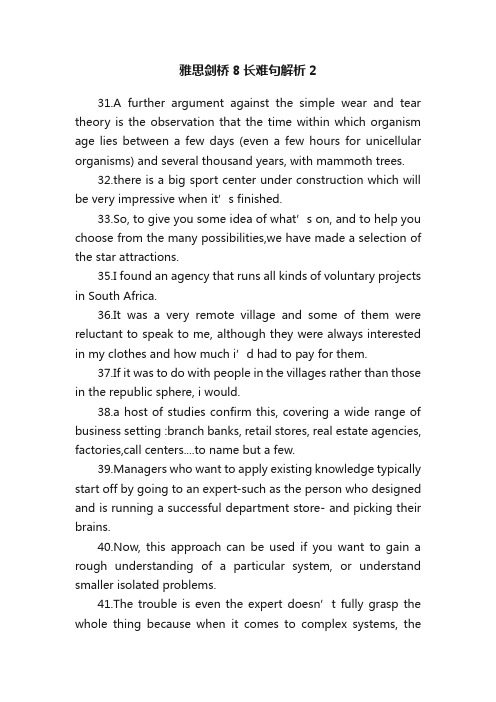
雅思剑桥8长难句解析231.A further argument against the simple wear and tear theory is the observation that the time within which organism age lies between a few days (even a few hours for unicellular organisms) and several thousand years, with mammoth trees.32.there is a big sport center under construction which will be very impressive when it’s finished.33.So, to give you some idea of what’s on, and to help you choose from the many possibilities,we have made a selection of the star attractions.35.I found an agency that runs all kinds of voluntary projects in South Africa.36.It was a very remote village and some of them were reluctant to speak to me, although they were always interested in my clothes and how much i’d had to pay for them.37.If it was to do with people in the villages rather than those in the republic sphere, i would.38.a host of studies confirm this, covering a wide range of business setting :branch banks, retail stores, real estate agencies, factories,call centers....to name but a few.39.Managers who want to apply existing knowledge typically start off by going to an expert-such as the person who designed and is running a successful department store- and picking their brains.40.Now, this approach can be used if you want to gain a rough understanding of a particular system, or understand smaller isolated problems.41.The trouble is even the expert doesn’t fully grasp the whole thing because when it comes to complex systems, theindividual components of the process are interwoven one another.42.Glass, which has been made since the time of the Mesopotamian and Egyptians, is little more than a mixture of sand, soda ash and lime.43.When heated to about 1500 degree Celsius this becomesa molten mass that hardens when slowly cooled.44.The rest of the concept relied on gravity, which guaranteed that the surface of the molten metal was perfectly flat and horizontal.45.if the glass were kept hot enough, it would flow over the molten tin until the top surface was also flat, horizontal and perfectly parallel to the bottom surface.46.Nevertheless, demand for flat glass was very high and glassmakers across the world were looking for a method of making it continuously.。
雅思阅读长难句

英语的基本句式结构其实很简单:主谓宾和主系表。
主谓宾是“谁-做-什么”,例如:比如“羊吃草”;“洁白可爱的小绵羊蹦蹦跳跳欢快活泼地在一望无垠的广阔草原上幸福愉快地吃着鲜嫩碧绿的青草”一样也是主谓宾,只不过多了一些修饰的词,句子的核心意思还是“羊吃草”。
主系表是“谁-是-什么”,同主谓宾一样。
在阅读中我们要很快的找出核心句子,不用每句话的意思都懂,但要知道这句话要表达的核心意思,即找到主谓宾或主系表的主体。
hometothousandsormillionsofpeople为world的同位语。
中文:但是随着人们重新关注杀虫剂对农产品的影响.以及红外线扫描技术的改进,Paley希望能重操旧业。
Butwiththerenewedconcernaboutpesticidesonproduce,andrefinementsininfraredscanning,Paleyhopestoget backintooperation.结构分析:with带两个宾语:renewedconcern…和refinements...,整个短语作状语。
中文:那位中世纪的学者几乎没有尝试着去调查植物的解剖结构、生长机制,以及它们相互之是:(一。
结构分析:onecaresaboutorwants是thethings的定语从句。
这个句子相对来说还是比较简单的,但其实复杂句也是一样的。
中文:另一个基于利益的过程叫做调解,在调解中一个第三方帮助冲突者,即在冲突中的双方.达成一致。
Anotherinterestsbasedprocedureismediation,inwhichathirdpartyassiststhedisputants,thet wosidesinthedispute,inreaching-agreement.inwhich引出的定语从句inwhichathirdpartyassiststhedisputants,thetwosidesinthedispute,inreaching-agreement是对“交谈,并对病人的身体状况做全面记录.内容包括从病史到病人情绪的一切事情。
雅思阅读长难句单句解析(二)

雅思阅读长难句单句解析(二)分割结构是一种修辞手段,在英语句子中,特别是在书面语中,比较常见。
分割结构就是指把英语句子中原来属于一个整体的句子成分分割开,一部分留在句子的原来位置,另一部分远离原来位置。
如:The best books are treasuries of good words,thegoldenthoughts,which,remembered and cherished,become our constant companions andcomforters. 不难看出which become our constant companions andcomforters原本是一个整体,被用作状语的过去分词remembered andcherished分割开。
常见的分割结构形式有同位语或同位语从句与先行词的分割,定语或and定语从句与先行词的分割,主语与谓语的分割,谓语与宾语的分割。
使用分割结构的目的是使语句结构平衡,避免头重脚轻,或者为了使表达的主题思想更加突出醒目,读起来更通顺流畅。
分割结构的存在说明了英语在结构形式和表达方法上的生动性和灵活性,但也造成了句子结构的错综复杂。
对于分割结构,只有从结构上和语意上弄清它才能避免理解上的错误,英译汉时要把原来属于一个整体部分的意义译出。
如:An unusual present was given to him for his birthday,a book onethics.过生日的时候他得到了一件不寻常的礼物——一本关于伦理道德的书。
(present 和a book被分隔)再如:After Galileo's work the feeling grew that there were universal lawsgoverning the motion of bodies and that these laws might apply to motion in theheavens as well as onearth.在伽利略著作之后,这样的认识加强了,即认为存在着支配物体运动的普遍规律,这些规律不仅支配着地球上的也支配着天体上的物体的运动。
剑桥雅思八 阅读 test 2 passage 2 核心词汇分解

剑桥雅思八test 2 passage 2核心词汇providevt.& vi. 提供,供给,供应vt. 规定;提供(+for);装备;预备vi. 抚养,赡养(+for);做准备;预约(for 或against)detailedadj. 详细的,明细的;精细的;复杂的;详尽的v. 详细说明(detail的过去分词)examinationn. 检查;考试;询问,审问climatic shift = climate change气候变化embarkvi. 上飞机,上船;着手,从事vt. 使…上船或飞机;使从事,使着手;投资于historicaladj. 历史的,历史上的;有关历史研究的;有根据的;基于史实的contextn. 上下文;背景;环境;语境tend to倾向于think of考虑;想起;有…想法;对…有意见认为climaten. 气候;水土,风土;(社会思想等的)趋势,倾向;思潮opposevt.& vi. 反对,抗争;使相对;使对照;抵制weathern. 天气,气象;暴风雨vt.& vi. 晒干,风化vt. 平安渡过,挨过;[地]使风化unchangingadj. 不变的,恒常的humanityn. 人类;人性;人道;人文学科at the mercy of任…摆布,在…前毫无办法mercyn. 宽容;怜悯;幸运;侥幸entireadj. 全部的;整个的;全体的;囫囵existencen. 存在,实在;生活,生活方式;实体,存在物glacialadj. <地>冰的,冰河[川]的;冰河期的;极冷的episoden. 插曲,片断;插话;一集ancestorn. 祖先,祖宗;被继承人;原型;(动物的)原种,先祖adaptvi. 适应于,适应不同情况(或环境)(to) vt. 改编,改写;改变…以适合(for)universaladj. 普遍的,一般的;通用的,万能的;全世界的;宇宙的n. [逻辑学]全称命题;[哲学]一般概念;一般性irregularadj. 不规则的,不对称的;无规律的;不合规范的,不合法的;不规则变化的n. 非正规军军人;不规则物;不合规格的产品globaladj. 全球的,全球性的,有关全球大局的;全面的,整体的,全局的;球形的,球状的,球面的,球体的;[计]全程的warmingadj. (比赛前的)准备动作的,热身的n. 加温,升温v. (使)变暖,被加热,暖和起来( warm 的现在分词);(使)变得更友好,变得更可爱dazzlingadj. 耀眼的,光彩夺目的;灿烂的v. (使)眼花(dazzle的ing形式)opportunismn. <贬>机会主义,投机取巧strategiesn. 策略( strategy的名词复数);战略;战略学;对策survivingadj. 继续存在的,未死的,依然健在的v. 幸存,活下来( survive的现在分词);比…活得长,经历…之后还存在;幸免于难;挺过harshadj. 粗糙的;刺耳的;严厉的,严格的;残酷的droughtn. 干旱(时期),旱季;旱灾;(长期的)缺乏;枯竭cyclen. 循环,周期;自行车;时代,一段时间;整套vi. 周而复始,循环;骑自行车;轮转vt. 运转,循环;使轮转decaden. 十年,十年间;十个一组;十年期rainfalln. 阵雨,降雨;降雨量unaccustomedadj. 不习惯的;不寻常的;奇怪的;不熟悉的adoptvt. 采用,采取,采纳;收养;正式接受,接受;批准agriculturen. 农业;农耕;农业生产;农学stock-raising养殖牲畜revolutionized (sed)v. 使彻底变革( revolutionize的过去式和过去分词)foundvt. 创办,成立,建立v. 发现( find的过去式);找到;到达;发觉pre-industrialadj. 工业化前的;未工业化的civilizationn. 文明,文化;开化,教化;修养;文明社会Egyptn. 埃及Mesopotamian. 美索不达米亚(西南亚地区)[地名] [希腊] 美索不达米亚;[地名] [伊拉克·叙利亚] 美索不达米亚(地区)America美洲pricen. 价格,价钱;代价;价值;赏金vt. 标价;定价;问…的价格;给…定价suddenadj. 突然的,未预见到的;急躁的,仓促的;快的,迅速的;急剧faminen. 饥荒;饥饿;极度缺乏diseasen. 疾病;弊端;不安vt. 传染;使…有病sufferingn. 受苦,遭难;苦楚,苦难;令人痛苦的事v. 受苦(suffer的现在分词);蒙受adj. 受苦的;患病的experiencen. 经验,体验;经历,阅历vt. 亲身参与,亲身经历;感受;发现bitterlyadv. 苦涩地;痛苦地;不痛快地;残酷地mountainn. 山,山岳;山脉;一大堆;大量glaciern. 冰河,冰川recodedv. 记录,录音,拍摄( record的过去式和过去分词);标明;发表正式(或法律方面的)声明;演奏音乐供录制memoryn. 记忆,记忆力;回忆,往事;[计]存储器,内存packn. 一群;包裹;(纸牌的)一副;一组vt.& vi. (把…)打包;塞进;拥进;(使)聚集成团vt. 挑选;压紧;携带;拧紧vi. 包装;紧挤在一起;便于折叠收藏的;匆忙离去(有时与off 连用)surroundedadj. (后面与by,with连用)被…环绕着的v. 包围( surround的过去式和过去分词);与…紧密相关;围绕;喜欢结交(某类人)more than不只是;很;超过;在…次以上shapen. 形状;模型;状态;身材vt. 塑造;使符合;体现vi. 使成形;形成modernadj. 现代的;近代的;新式的;当代风格的n. 现代人,现代主义者;时髦人士;[印]现代字体,指印刷中所用的一种字体currentadj. 现在的;最近的;流行的;流传的n. 趋势;电流;水流;涌流unprecedentedadj. 前所未有的,无前例的;空前的;无比的;新奇的,崭新的freezevt. 使结冰,使冻僵;冷藏;吓呆;冻结(存款,工资等)vi. 凝固,结冰;冻伤,冻死n. 冻结;严寒时期seesawn. 跷跷板,上下动adj. 前后动的,交互的vt. 使上下(来回)摇动vi. 玩跷跷板,上下(来回)摇动rapidadj. 快速的;[摄]感光快的;险峻的n. 急流;高速交通工具,高速交通网v. 驾驶;开车;驱动;迫使n. 驱车旅行;驱动力;车道;驱动器complexadj. 复杂的;合成的n. 复杂;合成体;[数学]复数interactionn. 一起活动;合作;互相影响;互动atmospheren. 大气,空气;大气层;风格,基调;气氛broughtv. 带来( bring的过去式和过去分词);促使;提供;使朝(某方向或按某方式)移动intenselyadv. 强烈地;极度;剧烈地easterlyadj.& adv. 东方的(地),东部的(地);(指风)从东吹来的(地)switchn. 开关;转换,转换器;软鞭子;[信]接线台vt.& vi. 转变,改变;转换;关闭电流;鞭打vt. 转换;挥动(棍棒、鞭子等);迅速转动;鞭打vi. 交换;调换abruptlyadv. 突然地;意外地;(言谈举止)唐突地;<地质>陡起地frequentadj. 频繁的,时常发生的,常见的;(脉搏等)急促的,快的[friˈkwent] vt. 常到,光顾,常与…交往;常去,时常出入于Atlantic在大西洋里的,近大西洋的(the Atlantic)大西洋[地名] [美国] 大西洋城stormn. 暴风雨,暴风雪;[军]猛攻,冲击;骚乱;动荡vi. 起风暴,下暴雨;猛冲;暴怒vt. 袭击,猛攻;暴怒,怒骂;大力迅速攻占periodn. 时期;(一段)时间;学时;句号adj. 具有某个时代特征的;(关于)过去某一特定历史时期的;(家具、服饰、建筑等)某一时代的n. 波浪,波动;挥手;涌现的人(或事物);汹涌的行动(或思想)态势vi. 摇摆,起伏vt.& vi. (一端固定地)飘扬;挥手指引;挥动…示意;略呈波形vt. 挥手表示;挥舞;使…略呈波形;烫(发)reconstructingv. 重建( reconstruct的现在分词);重现,重整extremelyadv. 极端地;非常,很;去;绝systematicadj. 有系统的,有规则的;有条不紊的;有步骤的;一贯的,惯常的observationn. 观察;观察力;注意;观察报告tropicaladj.热带的;炎热的;热情的recentadj. 最近的;新近的;近代的;[地]全新世的proxyn. 代表权;代理人,代替物;委托书;代理服务器reconstructedadj. 重建的,改造的v. 重建( reconstruct的过去式和过去分词);重现,重整tree ringn. 树木的年轮ice coren .冰芯在冰川、冰原上所钻取的冰体岩芯。
雅思阅读长难句式2

16. If it is not clear, through role signs of one sort or another , which role is currently theoperational one, the other party may not react in the appropriate way ------we may , in fact, hear quite another message if the focal person speaks to us ,for example, as a teacher and we hear her as an executive.如果通过这样、那样的角色标记,还不清楚哪一个角色目前正在起作用,那么另一方就不会做出适当的反应-----举个例子,如果焦点人物以教师身份通我们讲话而我们把她当作经理来听,我们实际上听到的可能是另一类信息。
17.Particularly interesting are a series of collections which continue to document the evolution of ceremony and of material forms for which the Department already possesses early (if not the earliest ) collection formed after the first contact with European.特别有趣的是,一系列的收藏品继续要以实证来说明礼节仪式和物质形态的演变过程,为此目的,该馆原有的早期(如果还算不上是最早的话)馆藏展品可与佐证,这些馆藏展品形成于和欧洲人初次接触之后。
18. The belief that rain and murky weather make people more unhappy is borne out by a study inBelgium, which showed that a telephone counseling service gets more telephone calls from people with suicidal feelings when it rains.相信阴沉的雨天会让人们更不开心的观点被比利时的一项研究证实,这项研究显示:一项电话心理咨询服务在雨天接到更多的带有自杀情绪的人打来的电话。
剑桥实例分析带你轻松攻克雅思阅读长难句
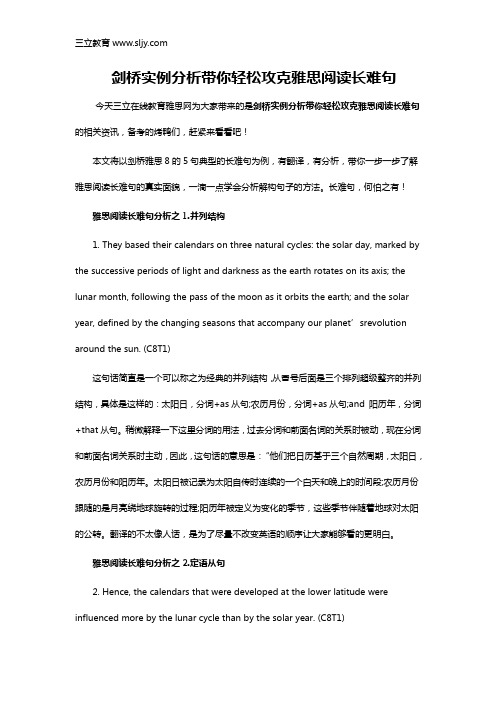
剑桥实例分析带你轻松攻克雅思阅读长难句今天三立在线教育雅思网为大家带来的是剑桥实例分析带你轻松攻克雅思阅读长难句的相关资讯,备考的烤鸭们,赶紧来看看吧!本文将以剑桥雅思8的5句典型的长难句为例,有翻译,有分析,带你一步一步了解雅思阅读长难句的真实面貌,一滴一点学会分析解构句子的方法。
长难句,何怕之有!雅思阅读长难句分析之1.并列结构1. They based their calendars on three natural cycles: the solar day, marked by the successive periods of light and darkness as the earth rotates on its axis; the lunar month, following the pass of the moon as it orbits the earth; and the solar year, defined by the changing seasons that accompany our planet’srevolution around the sun. (C8T1)这句话简直是一个可以称之为经典的并列结构,从冒号后面是三个排列超级整齐的并列结构,具体是这样的:太阳日,分词+as从句;农历月份,分词+as从句;and 阳历年,分词+that从句。
稍微解释一下这里分词的用法,过去分词和前面名词的关系时被动,现在分词和前面名词关系时主动,因此,这句话的意思是:“他们把日历基于三个自然周期,太阳日,农历月份和阳历年。
太阳日被记录为太阳自传时连续的一个白天和晚上的时间段;农历月份跟随的是月亮绕地球旋转的过程;阳历年被定义为变化的季节,这些季节伴随着地球对太阳的公转。
翻译的不太像人话,是为了尽量不改变英语的顺序让大家能够看的更明白。
雅思阅读长难句分析之2.定语从句2. Hence, the calendars that were developed at the lower latitude were influenced more by the lunar cycle than by the solar year. (C8T1)首先我们需要注意到这里有个定语从句that were developed at the lower latitude,撇开从句先来看主句内容:因此,和阳历比起来,日历被农历循环影响的更多。
雅思长难句2

雅思阅读长难句一:For example, vision is obviously more useful to species inhabiting clear open waters than to those living in turbid rivers and flooded plains.(C4T1P2)雅思阅读长难句解析:整个句子是由more… than… 引导的比较状语从句,然后分别在名词species 和代词those的后面插入了非谓语动词的现在分词“inhabiting clear open waters”和“living in turbid rivers and flooded plains”做后置定语。
长难句翻译:比如说,对于宽广清澈水域中的鲸鱼来说,视觉显然就比住在混浊的河流或者水淹的平原上的品种来说更加有用。
雅思阅读长难句二:Quite often, governments try to kill off a minority language by banning its use in public or discouraging its use in schools, all to promote national unity. (C4T2P1)雅思阅读长难句解析:整个句子首先用quite often 副词插入句子头表示强调,主语是governments, 谓语是try,后面不定式短语to kill off a minority language 做宾语,然后加上介词by引导的的方式状语,最后插入一个to引导的目的状语。
长难句翻译:为了增加国家的凝聚力,政府通常会通过在公共场合禁用以及在学校中不提倡使用的方法,消灭少数民族语言。
雅思阅读长难句三:Animals at play often use unique signs-tail-wagging in dogs, for example-to indicate that activity superficially resembling adult behavior is not really in earnest.(C4T2P3)雅思阅读长难句解析:这句话的主语是animals,谓语是use,宾语是signs,双破折号当中的部分是插入语,to indicate是宾语补足语,indicate后面跟了一个宾语从句。
专八英语阅读长难句分析(2)
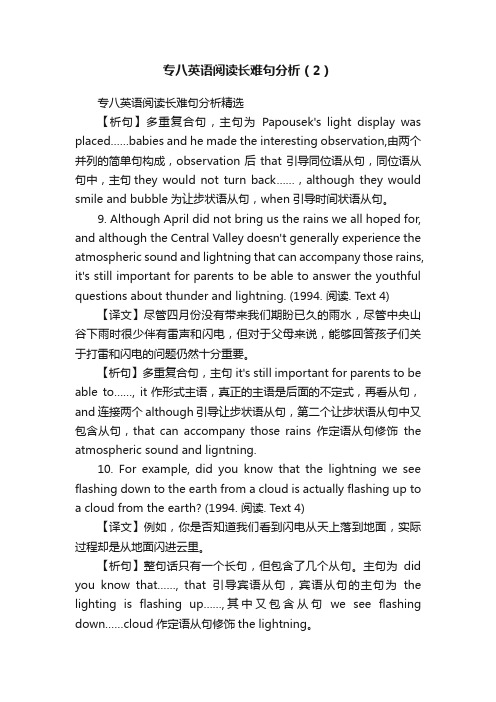
专八英语阅读长难句分析(2)专八英语阅读长难句分析精选【析句】多重复合句,主句为Papousek's light display was placed……babies and he made the interesting observation,由两个并列的简单句构成,observation后that引导同位语从句,同位语从句中,主句they would not turn back……,although they would smile and bubble为让步状语从句,when引导时间状语从句。
9. Although April did not bring us the rains we all hoped for, and although the Central Valley doesn't generally experience the atmospheric sound and lightning that can accompany those rains, it's still important for parents to be able to answer the youthful questions about thunder and lightning. (1994. 阅读. Text 4) 【译文】尽管四月份没有带来我们期盼已久的雨水,尽管中央山谷下雨时很少伴有雷声和闪电,但对于父母来说,能够回答孩子们关于打雷和闪电的问题仍然十分重要。
【析句】多重复合句,主句it's still important for parents to be able to……, it作形式主语,真正的主语是后面的不定式,再看从句,and连接两个although引导让步状语从句,第二个让步状语从句中又包含从句,that can accompany those rains作定语从句修饰the atmospheric sound and ligntning.10. For example, did you know that the lightning we see flashing down to the earth from a cloud is actually flashing up to a cloud from the earth? (1994. 阅读. Text 4)【译文】例如,你是否知道我们看到闪电从天上落到地面,实际过程却是从地面闪进云里。
雅思阅读长难句分析

1. 【雅思长难句分析】1-5雅思阅读长难句分析:1And it is imagined by many that the operations of the common mind can be by no means compared with these processes and that they have to be acquired by a sort of special training.雅思阅读长难句分析:2Whether the government should increase the financing of pure science at the expense of techno logy or vice versa(反之) often depends on the issue of which is seen as the driving force. 雅思阅读长难句分析:3How well the predictions will be validated by later performance depends upon the amount, reliability, andAppropriateness of the information used and on the skill and wisdom with which it is interpreted.雅思阅读长难句分析:4There is no agreement whether methodology refers to the concepts peculiar to historical work in general or to theResearch techniques appropriate to the various branches of historical inquiry.雅思阅读长难句分析:5Furthermore, it is obvious that the strength of a country’s economy is directly bound up with the efficiency of itsagriculture and industry , and that this in turn rests upon the efforts of scientists and technologists of all kinds.---------------------------1-5答案------------------答案:and it is imagined by many that the operations of the common mind can be by no means compared with theseprocesses, and that they have to be acquired by a sort of special training. 要点:句子的框架是and it is imagined … that…, and that …。
雅思剑桥8长难句解析

1.Thank you for asking me to your teacher’s meeting to talk about the dinosaur museum and to tell you a bit about what you can do with your students there.2.In regard to opening hours, we are open every day of the week from 9.00am to 8.00pm except on Mondays when we close at 1.30pm.3.When the students come into the museum foyer we ask them to check in their backpacks with their books, lunch boxes,etc.,at the cloakroom before they enter the museum proper.4.We used to have an activity room with more interactive things like making models of dinosaurs and drawing and painting pictures, even hunting for dinosaur eggs.5.In fact, i only have a few things to say about it,but even in an outline document like this you really have to be careful to avoid typos and problems with layout in the proposal,and even in the contents page.6.it would be a good idea to include the answers in your finished proposal,because they are missing from your draft.7.We learn a great deal about all the the processes that have affected and that continue to affect the earth’s surface.8.They circle the earth several times a day and can provide a mass of information they give us about the weather, for example.9.We also need images of the earth’s surface which we can produce by means of computer-generation technology or with the help of satellite relays.10.We have come a very long way from the early exploration of the world by sailing ships when geographers only had pens and paper at their disposal.11.These are very popular with the public but of course.we mustn’t lose sight of the main purpose of having this section,not as such to preserve rare animals but to maintain the diversity of breeds to broaden the gene pool for agricultural development.12.May will be perhaps our most spectacular month with the arrival of the Canada geese and when our fruit trees will be in full blossom, but there are interesting events on all year round.13.Then they bring up all the indigestible bits of skeleton and ,of course, the wings in a Pellet---a small ball of waste material which they cough up.14.so far our research shows that Asian bees have not entered Australia in any number--it’s a good result and much more reliable than trying to find living ones as evidence of introduced insects.15.Now i had to set up my program of research in three different countries so i approached postgraduates in my field in overseas department, contacting them by email, to organize for me at their end.ernment reforms have been proposed at all levels and although their success is not guaranteed , long-term hospital care is in fact probably less of an issue than the media would have us believe.17.Certainly i will need to do more far-reaching research than i had anticipated in order to establish if people want extra medical staff invested in the community, or if they want care to revert to fewer, but larger, key medical units.18.But i was taken aback and rather concerned that something i thought i’d set up very well didn’t necessarily seem that way to everyone in my own department.19.There are odd cases that threw me ---one of the subjects who i had approached while he was out shopping in town, decided to pull out when it came to the second round.20.We are going to get school children in the area to research a local story, the life of a local sports hero perhaps, and an artist will incorporate that story into paintings on the wall of a building onthe other side of Hill Street from the supermarket.21.It was practically a year ago that i applied to my local council for a grant,and it took them six months to turn me down.22.And i also joined the debating society. It’s fun,but with all the rehearsing i’m doing something has to go.23.Maybe you need to do something different every day, so if you break down your revision into small tasks and allocate them to specific days,there’s more incentive to tackle them24.The Australian Aborigines have recorded both real and symbolic images of their time on rock walls for many thousands of years.25.However, They didn’t go as far as the Modern style , which is known as ‘X-ray’because it actually makes a feature of the internal skeleton as well as the organs of animals and human.26.The Yam style of painting got its name from the fact that it featured much curvier figures that actually resemble the vegetable called a yam, which is similar to a sweet potato.27.Aborigines managed to convey the idea of the settlers’clothing by simply painting the Europeans without any hands, indicating the habit of standing with their hands in their pockets.28.The paintings of the Yam tradition also suggest that, during this time, the Aborigines moved away from animals as their main food source and began including vegetables in their diets ,as these feature prominently.29.But we decided to study the Rainbow Serpent paintings to see if we could local the animal that the very first painters based their image on.30.This flooded many familiar land features and also caused a great deal of disruption to traditional patterns of life, hunting in particular.。
2020年专业8级英语阅读长难句分析2完整篇.doc
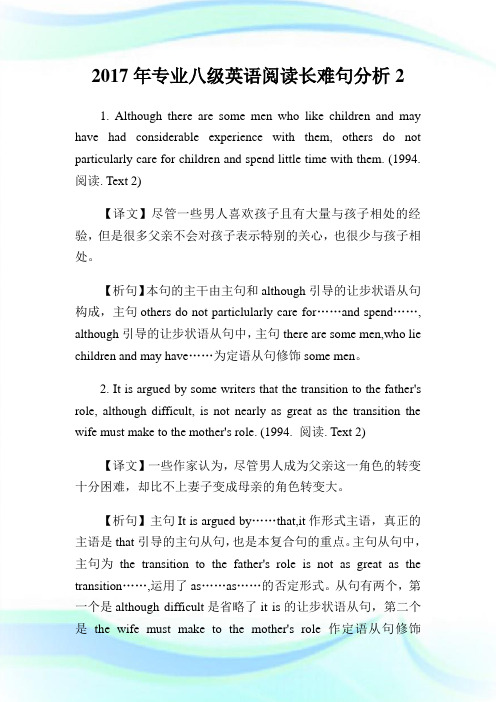
2017年专业八级英语阅读长难句分析21. Although there are some men who like children and may have had considerable experience with them, others do not particularly care for children and spend little time with them. (1994. 阅读. Text 2)【译文】尽管一些男人喜欢孩子且有大量与孩子相处的经验,但是很多父亲不会对孩子表示特别的关心,也很少与孩子相处。
【析句】本句的主干由主句和although引导的让步状语从句构成,主句others do not particlularly care for……and spend……, although引导的让步状语从句中,主句there are some men,who lie children and may have……为定语从句修饰some men。
2. It is argued by some writers that the transition to the father's role, although difficult, is not nearly as great as the transition the wife must make to the mother's role. (1994. 阅读. Text 2)【译文】一些作家认为,尽管男人成为父亲这一角色的转变十分困难,却比不上妻子变成母亲的角色转变大。
【析句】主句It is argued by……that,it作形式主语,真正的主语是that引导的主句从句,也是本复合句的重点。
主句从句中,主句为the transition to the father's role is not as great as the transition……,运用了as……as……的否定形式。
- 1、下载文档前请自行甄别文档内容的完整性,平台不提供额外的编辑、内容补充、找答案等附加服务。
- 2、"仅部分预览"的文档,不可在线预览部分如存在完整性等问题,可反馈申请退款(可完整预览的文档不适用该条件!)。
- 3、如文档侵犯您的权益,请联系客服反馈,我们会尽快为您处理(人工客服工作时间:9:00-18:30)。
剑桥雅思8的阅读长难句汇总(2)
雅思阅读考试中,文章里时不时就会出现几句长难句,这些长难句由几十个单词组成,复杂的句子成分,很容易让考生难以摸清大意,很多因此丢分的考生都直呼“心塞”。
小编整理了剑桥雅思8中的几类雅思阅读长难句,希望对大家有所帮助!
剑桥雅思8的雅思阅读长难句——并列与比较结构
Hence, the calendars that were developed at the lower latitudes were influenced more by the lunar cycle than by the solar year.
The revolutionary aspect of this new timekeeper was neither the descending weight that provided its motive force nor the gear wheels that transferred the power.
雅思阅读长难句1:主语从句
What they are certainly not finding, however, is any change in attitude of mainstream scientists.
雅思阅读长难句2:倒装句
Only when many studies are combined in a meta-analysis will the faint signal of telepathy really become apparent.
雅思阅读长难句3:表语从句
The implication was that ganzfeld method had revealed real evidence for telepathy.
That is what researchers do seem to be finding.
雅思阅读长难句4:同位语及同位语从句
Sceptics(skeptics) and advocates alike do concur on one issue, however: that the most impressive evidence so far has come from the so-called ‘ganzfeld’ experim ents, a German term that means ‘whole field’.
Some researchers say the results constitute compelling evidence that telepathy is genuine.
雅思阅读长难句5:复合从句
留学改变人生,教育改变中国!
Reports of telepathic experiences had by people during meditation led parapsychologists to suspect that telepathy might involve signals passing between people that were so faint that they were usually swamped by normal brain activity.
雅思阅读长难句6:表语从句
The idea was that a person acting as a ‘sender’ would attempt to beam the image over to the ‘receiver’ relaxing in the sealed room.
雅思阅读长难句7:现在分词作后置定语
They drew up a list demanding new standards for future research.
雅思阅读长难句8:插入语
If, as current results suggest, telepathy produces hit-rates only marginally above the 25 per cent expected by chance. It’s unlikely to be detected by a typical ganzfeld study involving around 40 people: the group is just not big enough.
The problem stems at least in part from the lack of any plausible mechanism for telepathy.
更多雅思机经下载,点击↓↓进入免费下载
/gz/
留学改变人生,教育改变中国!。
